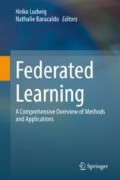Abstract
Resource constraints, workload overheads, lack of trust, and competition hinder the sharing of raw data across multiple institutions. This leads to a shortage of data for training state-of-the-art deep learning models. Split Learning is a model and data parallel approach of distributed machine learning, which is a highly resource efficient solution to overcome these problems. Split Learning works by partitioning conventional deep learning model architectures such that some of the layers in the network are private to the client and the rest are centrally shared at the server. This allows for training of distributed machine learning models without any sharing of raw data while reducing the amount of computation or communication required by any client. The paradigm of split learning comes in several variants depending on the specific problem being considered at hand. In this chapter we share theoretical, empirical, and practical aspects of performing split learning and some of its variants that can be chosen depending on the application of your choice.
Access this chapter
Tax calculation will be finalised at checkout
Purchases are for personal use only
References
Konečnỳ J, McMahan HB, Yu FX, Richtárik P, Suresh AT, Bacon D (2016) Federated learning: Strategies for improving communication efficiency. Preprint. arXiv:1610.05492
Gupta O, Raskar R (2018) Distributed learning of deep neural network over multiple agents. J Netw Comput Appl 116:1–8
Vepakomma P, Gupta O, Swedish T, Raskar R (2018) Split learning for health: Distributed deep learning without sharing raw patient data. Preprint. arXiv:1812.00564
Chen J, Pan X, Monga R, Bengio S, Jozefowicz R (2016) Revisiting distributed synchronous SGD. Preprint. arXiv:1604.00981
Lin Y, Han S, Mao H, Wang Y, Dally WJ (2017) Deep gradient compression: Reducing the communication bandwidth for distributed training. Preprint. arXiv:1712.01887
Han S, Mao H, Dally WJ (2015) Deep compression: Compressing deep neural networks with pruning, trained quantization and huffman coding. Preprint. arXiv:1510.00149
Louizos C, Ullrich K, Welling M (2017) Bayesian compression for deep learning. Preprint. arXiv:1705.08665
Laskin M, Metz L, Nabarro S, Saroufim M, Noune B, Luschi C, Sohl-Dickstein J, Abbeel P (2020) Parallel training of deep networks with local updates. Preprint. arXiv:2012.03837
Huo Z, Gu B, Huang H (2018) Training neural networks using features replay. Preprint. arXiv:1807.04511
Elthakeb AT, Pilligundla P, Mireshghallah F, Cloninger A, Esmaeilzadeh H (2020) Divide and conquer: Leveraging intermediate feature representations for quantized training of neural networks. In: International conference on machine learning. PMLR, pp 2880–2891
Gharib G, Vepakomma P (2021) Blind learning: An efficient privacy-preserving approach for distributed learning. In: Workshop on split learning for distributed machine learning (SLDML’21)
Thapa C, Chamikara MAP, Camtepe S (2020) Splitfed: When federated learning meets split learning. Preprint. arXiv:2004.12088
Madaan H, Gawali M, Kulkarni V, Pant A (2021) Vulnerability due to training order in split learning. Preprint. arXiv:2103.14291
Han DJ, Bhatti HI, Lee J, Moon J (2021) Han DJ, Bhatti HI, Lee J, Moon J (2021) Accelerating federated learning with split learning on locally generated losses. In: ICML 2021 workshop on federated learning for user privacy and data confidentiality. ICML Board
Singh A, Vepakomma P, Gupta O, Raskar R (2019) Detailed comparison of communication efficiency of split learning and federated learning. Preprint. arXiv:1909.09145
Poirot MG, Vepakomma P, Chang K, Kalpathy-Cramer J, Gupta R, Raskar R (2019) Split learning for collaborative deep learning in healthcare. Preprint. arXiv:1912.12115
Ceballos I, Sharma V, Mugica E, Singh A, Roman A, Vepakomma P, Raskar R (2020) SplitNN-driven vertical partitioning. Preprint. arXiv:2008.04137
Dingledine R, Mathewson N, Syverson P (2004) Tor: The second-generation onion router. Technical report, Naval Research Lab Washington DC
Sharma V, Vepakomma P, Swedish T, Chang K, Kalpathy-Cramer J, Raskar R (2019) Expertmatcher: Automating ML model selection for clients using hidden representations. Preprint. arXiv:1910.03731
Singh A, Chopra A, Garza E, Zhang E, Vepakomma P, Sharma V, Raskar R (2020) Disco: Dynamic and invariant sensitive channel obfuscation for deep neural networks. Preprint. arXiv:2012.11025
Arachchige PCM, Bertok P, Khalil I, Liu D, Camtepe S, Atiquzzaman M (2019) Local differential privacy for deep learning. IEEE Internet Things J 7(7):5827–5842
Vepakomma P, Balla J, Raskar R (2021) Differentially private supervised manifold learning with applications like private image retrieval. Preprint. arXiv:2102.10802
Li O, Sun J, Yang X, Gao W, Zhang H, Xie J, Smith V, Wang C Label leakage and protection in two-party split learning. Preprint. arXiv:2102.08504
Abadi M, Chu A, Goodfellow I, McMahan HB, Mironov I, Talwar K, Zhang L (2016) Deep learning with differential privacy. In: Proceedings of the 2016 ACM SIGSAC conference on computer and communications security, pp 308–318
Author information
Authors and Affiliations
Corresponding author
Editor information
Editors and Affiliations
Rights and permissions
Copyright information
© 2022 The Author(s), under exclusive license to Springer Nature Switzerland AG
About this chapter
Cite this chapter
Vepakomma, P., Raskar, R. (2022). Split Learning: A Resource Efficient Model and Data Parallel Approach for Distributed Deep Learning. In: Ludwig, H., Baracaldo, N. (eds) Federated Learning. Springer, Cham. https://doi.org/10.1007/978-3-030-96896-0_19
Download citation
DOI: https://doi.org/10.1007/978-3-030-96896-0_19
Published:
Publisher Name: Springer, Cham
Print ISBN: 978-3-030-96895-3
Online ISBN: 978-3-030-96896-0
eBook Packages: Computer ScienceComputer Science (R0)

